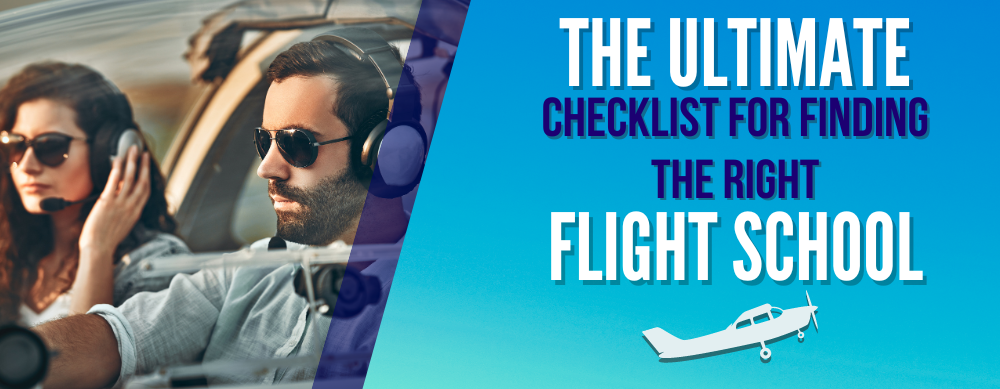The Ultimate Checklist for Selecting the Right Flight School

Featured Pilot Gear
Browse our selection of high-quality pilot supplies! Your purchase directly supports our small business and helps us continue sharing valuable aviation content.
Pursuing a career as a pilot is an exhilarating aspiration, and one of the initial steps towards achieving it is selecting a flight school and instructor to guide you. With numerous flight schools and instructors to choose from, how do you determine the best fit for your needs?
Continue reading to learn about key factors to consider as you search for the ideal pilot training program to invest your time and resources in.
Understand Your Goals
Before you search for flight schools, understanding your goals is the foundational step in your journey toward becoming a pilot. Take the time to think about what drives your passion for aviation.
Are you seeking the adventures of recreational flying, or do you want to pursue a career as a professional pilot?
Figuring out the direction you wish to take will help you narrow down your options and adjust your training experience accordingly. Consider the type of training that best suits your learning style and your schedule.

Part 61
Part 61 training allows for a more individualized approach, you can be extremely flexible with your time and choose what days you want to fly. The downside of Part 61 is usually the study work you have to do on your own.
NOTE: The FAA provides an archive that explains in more technical terms the regulations for Part 61 operations.
Part 141
Part 141 training follows a structured curriculum, designed to expedite the learning process, and align your choice with your goals and preferences.
NOTE: For some technical reading, you can read information on Part 141 from the FAA's website.
Check Requirements
Once you've identified what your goals are, research the specifics of your aviation journey. Look into the requirements and prerequisites for obtaining a student pilot certificate and a Private Pilot Certificate or advancing to instrument ratings and a Commercial Pilot License.
Learn about the regulatory frameworks governing flight training, including the Federal Aviation Administration (FAA) regulations and information outlined in the most recent copy of the FAR/AIM.
 Research Flight Schools
Research Flight Schools
Airline Career Pilot Program
Provider: ATP
URL: https://atpflightschool.com/airline-career-pilot-program/
ATP Flight Schools are famously known for their comprehensive training programs tailored for aspiring professional pilots who want to go all the way to the airlines.
You can start your flight training from scratch and work your way up to 1500 hours. This may not be the most flexible option, but it's perfect for high school graduates looking to rapidly acquire valuable skills or individuals seeking a career change who are willing to dedicate time and resources to reach their goals.
Take a look at their website, the curriculum, fleet, qualifications of instructors, and success rate of the ATP Flight School to see if it meets your goals.
Flight School Finder
From Part 61 to Part 141, the AOPA provides a great tool for searching and finding flight schools located in the United States.
URL: https://www.aopa.org/training-and-safety/learn-to-fly/flight-schools
Evaluate Flight Instructor Credentials
Finding the right Certified Flight Instructor (CFI) matters, they are in charge of making sure that your flight training molds your skills and equips you with knowledge for success.
Seek out flight instructors who are properly certified, and have a genuine passion for teaching.
Do some research by seeking recommendations or reading reviews from previous students to get an idea of the level of instruction they provide.
Keep in mind that your flight instructor will have a big impact on your growth as a pilot, so choose carefully.
 Consider Accredited Universities
Consider Accredited Universities
If you are considering pursuing a career in aviation, you might decide that you want to go through a degree-based aviation program through an accredited university.
Accreditation guarantees that the program meets strict standards set by recognized aviation organizations, ensuring a high-quality education and training experience.
When researching accredited universities, look for reputable aviation programs that offer a balanced curriculum of flight training and academic coursework toward your chosen degree.
These programs provide hands-on flying experience as well as theoretical knowledge in areas such as safety, aircraft systems, and meteorology, preparing you for a successful career in aviation.
On top of quality education, accredited universities may offer other benefits such as access to top-of-the-line facilities, partnerships with industry leaders, and resources for post-graduation career opportunities.
Consider universities with connections to major airlines or pathways toward employment within the aviation industry.
Check out our guide on the "11 Best Flight Schools in the USA" for a list of options.
 Assess Training Facilities and Aircraft
Assess Training Facilities and Aircraft
Before enrolling in flight training, make sure to take a visit the flight school and assess the quality of their facilities. This includes evaluating the simulators, classrooms, and maintenance hangars.
Also make sure to examine the condition and variety of aircraft in the fleet to ensure they meet industry standards.
Consider the proximity of the training facilities to your location and the availability of amenities for student pilots. If you are pursuing a career as a pilot, keep in mind that training can take anywhere from 6-9 months, so make sure to factor in housing if necessary for completing the program.
 Aviation Scholarships
Aviation Scholarships
Take into consideration any aviation scholarships or financing options that may be available to assist you on your training journey.
We have also provided helpful guides on securing aviation scholarships and finding ways to pay in order to aid in this process.
Explore Aviation Career Opportunities
Explore the various career opportunities that are open to you after completing your pilot training, whether that is with general aviation or with major airlines.
Seek advice and mentorship from experienced career counselors or industry experts to gain a better understanding of the current job market for pilots and any anticipated future changes.
Stay updated on advancements in aviation technology and evolving regulations that may affect your career path.
Prioritize Ground School Education
A solid foundation in ground school education is vital for fully understanding the theoretical aspects of flight training. When selecting a flight school, prioritize ones that provide thorough ground school instruction covering key topics like aerodynamics, navigation, and regulations.
Also utilize online resources, textbooks, and interactive learning aids to supplement your studies in ground school.
We recommend the Gleim Private Pilot kit to start your training process.
Check out our guide on "Pass Your Private Pilot Checkride With Flying Colors" for insight into how to obtain your private pilot certificate.
Conclusion
As a pilot and writer, I know firsthand the importance of finding the right flight school and instructor to achieve your aviation dreams.
It's so important to understand your goals and do thorough research and find the flight school that suits your needs. Don't get discouraged if you end up going through several flight instructors or schools before you find the right fit.
You can achieve your dreams of becoming a pilot, and the skies eagerly await your presence. Fly safe!
Interested in Aviation-based Careers?
Our guides are designed to help!
Did you find this article helpful?
Do you think we missed anything important? Let us know in the comments below!
































